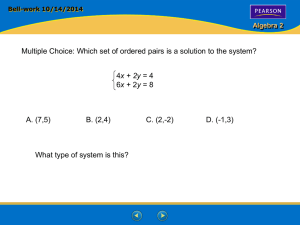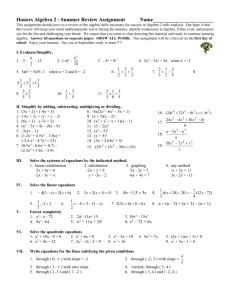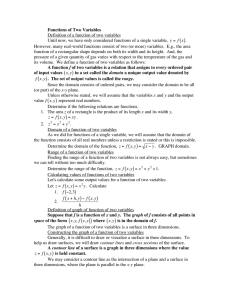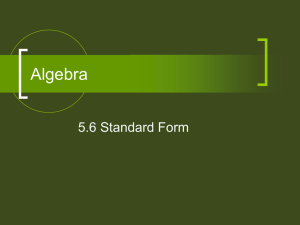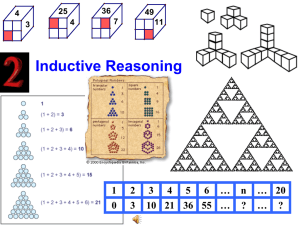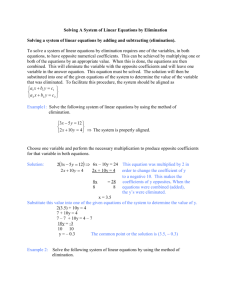Linear Functions And Graphs
advertisement
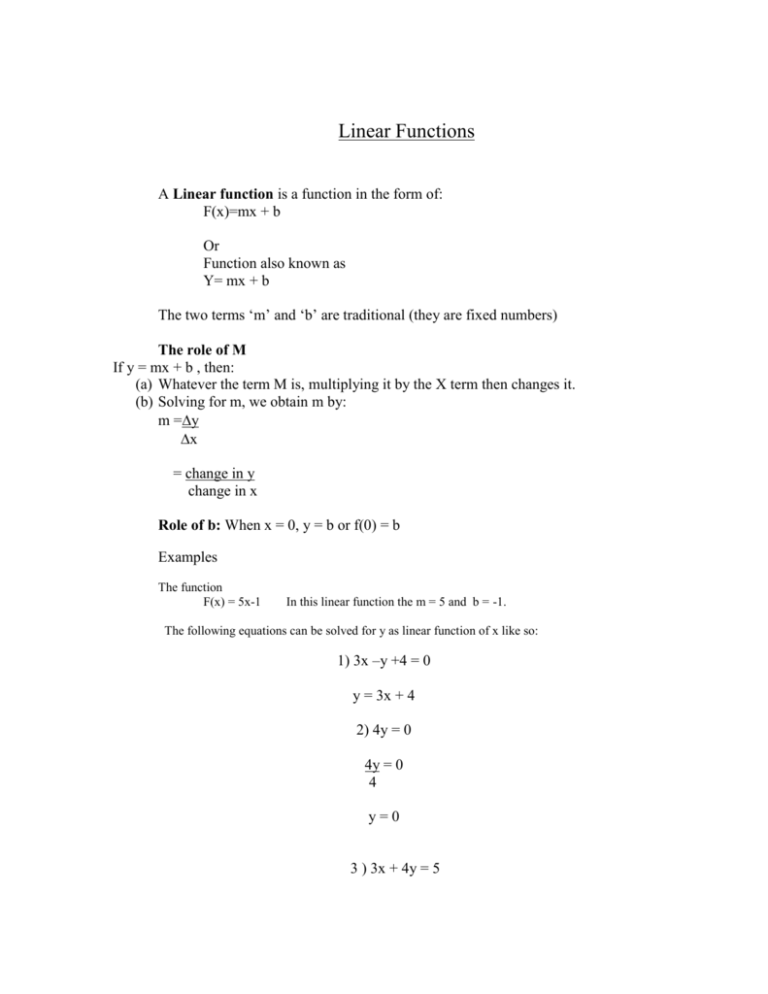
Linear Functions A Linear function is a function in the form of: F(x)=mx + b Or Function also known as Y= mx + b The two terms ‘m’ and ‘b’ are traditional (they are fixed numbers) The role of M If y = mx + b , then: (a) Whatever the term M is, multiplying it by the X term then changes it. (b) Solving for m, we obtain m by: m =y x = change in y change in x Role of b: When x = 0, y = b or f(0) = b Examples The function F(x) = 5x-1 In this linear function the m = 5 and b = -1. The following equations can be solved for y as linear function of x like so: 1) 3x –y +4 = 0 y = 3x + 4 2) 4y = 0 4y = 0 4 y=0 3 ) 3x + 4y = 5 4y = 5 + -3x 4 y = 5/4 + -(3/4)x There are many steps in linear function one in which is collecting your data and make a data table (0 (1 (2 (3 (4 , 1) , 3) , 5) , 7) , 9) these are you order pairs Step two create a data table by taking your order pairs and place them into the x and y points ( terms ) as shown. x y 0 1 1 3 2 5 3 7 4 9 The next step in the development a linear function is the graph, which has a horizontal axis that will represents the x points. A vertical axis represents the y points in your Data table. Ex: of your pairs in graph form The fourth step in linear function is to calculate the slope of the line on the graph. This is done in the following way: 1. You pick any two points on the in your graph with the ( x,y ) 2. Calculate the distance the line goes up from the two points that you have chosen. do this by counting the spaces up. 3. Do the same for the distance sideways . After that you divide they x known as the change in y over the change in x. This will find your slope. And the second y – the first y; the same for the x’s, the first x – the second x Ex: find the slope of the line that pass through ( 3 ,2 ) and ( 2 , 5 ) 5–2 2–3 = equals 3 -1 = equals -3 There is the graph that we just found the slope of the line of. The step that I have mentioned works for lines with positive slope. If your line is a negative slope, then take the negative of the ratio between the two distances. If you use this formula the sign will automatically be correct. Ex: 2 8–0 0 -5 = 8 -5 When you are given two equations, you can find where the two lines will intercept and find for the common ordered pairs. There are two methods for solving this. You can use the graphing method, or you can use the algebic method. The graphing method is simple, you just graph the two equations in y = mx + b, and record where they intercept. With a data table X 0 1 2 3 4 5 6 7 8 9 Y=4x + 2 2 6 10 14 18 22 26 30 34 38 X 0 1 2 3 4 5 6 7 8 9 Y=3x+10 10 13 16 19 22 25 28 31 34 37 The highlighted spot are the intercepting point. Solving with algebra. Y = 4x + 2 Y = 3x + 10 Substitute y with 3x + 10 3x + 10 = 4x + 2 -3x + 3x + 10 = 4x – 3x + 2 Subtract 3x from each side Remember what you do to one side you do to the other 10= x + 2 10 – 2 = x +2 – 2 8=x We wanted to know what x equaled so we isolated it from the other terms. You then can find y by simply placing the value of x in the unknown term ‘x’, in one of these equations. Y = 3x + 10 Y = 3(8) + 10 Y = 24 +10 Y = 34 Substitution 8x + 3y = 41 150x + 80y = 840 Rearrange one of the two equations to show the form y = mx + b the substitute it for y. 150x + 80y = 40 150x + 80( -8x + 41)= 840 3 150x + -640 = 840 – 3280 3 3 631/3x = -2531/3 x=4 You ,then take that x =4 and place it in a equation to find the valve of y 8(4) +3y=41 32-32 + 3y = 41-32 3y = 41-32 3y = 9 3 3 y=2 Elimination 8x + 3y + 41 -150(8x-3y = 41) –1200x + 450y = 6150 150x + 80y + 840(150x + 80y = 840) 1200x + 640y = 6720 190y = 570 190 190 y=3 Then take the three and put it back in the equation to get the x = value 8x + 3y = 41 8x + 3(3) = 41 8x = 41 – 9 8x = 32 x=4 For the following equations you will need to fill in x or y with zero to find the unknown term. Example: 5x – 2y = 10 Solution: Let x = 0.5(0) –2y = 10 -2y = 10 y = -5 (0,-5) Let y = 0.5x – 2(0) = 10 5x = 10 x=2 (2,0) Let x = 4.5940 –2y = 10 20 – 2y = 10 -2y = -10 y=5 (4,5) Letting x = 0 will give us the y-intercept Solve for y. Letting y = 0 will give us the x-intercept The third point is a check These points would be plotted and a line drawn through them to complete the graph. EXERCISE QUESTIONS Solve for x and y using zeros 1) 5x + 10y = 30 2) 3x + 9y + -18 3) –2x + 8y + 24 = 0 Solve for y = mx + b 4) 5x + 10y + 20 = 0 5) 9x –3y = -6 6) –6x + 4y – 12 = 0 Substitution 7) x = 2y – 1 & 2x + y = 3 8) x = 2y – 8 & x = 1 – y 9) x = 3y + 1 & 3x + y = 13 10) x = y + 2 & 2x – 3y = 2 Elimination 11) x= 2y + 4 x = 3y – 2 12) 3x + 4y = 5 5x – 4y = -13 13) 6x + 2y = 6 -9x + 2y = 9 Graph the following 14) y = 4x + 12 15) 2/3y = x - 6 EXERCISE ANSWERS 1) 5x + 10y = 30 5(0) + 10y = 30 10y = 30 10 10 y=3 5x + 10(0) = 30 5x = 30 5 5 x=6 2) -3x + 9y = -18 –3(0) + 9y = -18 9y = -18 9 9 y = -2 -3x + 9(0) = -18 -3x = -18 -3 -3 x=6 3) -2x + 8y + 24 = 0 -2(0) + 8y + 24 = 0 8y = -24 8 8 y = -3 -2x + 8(0) + 24 = 0 -2x = -24 -2 -2 x = 12 4) 5x + 10y + 20 = 0 5x + 10y = -20 10y = -5x –20 10 10 y = -1/2x - 2 5) 9x – 3y = -6 -3y = -9x -6 -3 -3 y = 3x + 2 6) -6x + 4y –12 = 0 -6x + 4y = 12 4y = 6x + 12 4 4 y = 3/2x + 3 7) x = 2y – 1 & 2x + y = 3 2(2y – 1) + y = 3 4y – 2 + y = 3 5y – 2 = 3 5y = 5 5 5 y=1 x = 2y -1 x = 2(1) - 1 x=1 8) x = 2y – 8 & x = 1 – y 2y –8 = 1 – y 3y –8 =1 3y = 9 3 3 y=3 9) x = 3y + 1 & 3x + y = 13 x = 3(1) + 1 x=3+1 x=4 x = 2y – 8 x = 2(3) – 8 x=6–8 x = -2 3(3y + 1) + y = 13 9x + 3 + y = 13 10y+ 3 = 13 10y = 10 10 10 y=1 10) x = y + 2 x=2+2 x=4 2x – 3y = 2 2(y + 2) + 3y = 2 2y + 4 + 3y = 2 -1y + 4 = 2 – 4 -1y = -2 -1 -1 y=2 11) x = 2y + 4 x = 3y -2 2y + 4 = 3y - 2 2y – 3y + 4 = -2 –4 2y – 3y = -2 –4 -1y = -6 -1 -1 y=6 x = 2(6) + 4 x = 12 + 4 x = 16 12) 3x + 4y =5 5x – 4y = -13 8x = -8 8 8 x = -1 3(-1) + 4y = 5 -3 + 4y = 5 4y = 8 4 4 y=2 13) 6x + 2y = 6 -9x + 2y = -9 -3x =-3 -3 -3 x=1 9(1) + 2y = 9 9 + 2y = 9 2y = 0 2 2 y=0 14) 15) Now that these questions have been completed, you’re ready for the real thing. Here is a mini quiz, do the following questions. Find the distance between the following ordered pairs with the slope. 1) (0,5) & (1,10) 2) (-4, 6) & (2, 10) 3) (-2, 15) & (3, 20) Find x and y intercepts for each of the following. 4) 3x + 2y = 12 5) 5x + 10 = 30 Rearrange each of the following into y = mx + b form. 6) 2y = 6x - 2 7) .6x + .2y – 4 = 0 8) 5y – x/4 = 1 9) 3y + x – 6 = 7 – 2x 10) 4x – 3y + 2x = y - 7 Answers for the mini quiz. 1) y2 – y1 = 10 – 5 = 5 = 5 X2 – X1 1–0 1 2) 20 – 15 = 5 = 5 3–2 1 3) 10 – 6 = 4 = -2 2 - 4 -2 4) 3x + 2y = 12 3(0) + 2y = 12 2y = 12 2 2 y=6 5) 5x +10y = 30 5(o) + 10y= 30 10y = 30 10 10 y=3 6) y + 3x - 1 7) 7 = -3x + 20 8) y = 1/20x + 1/5 9) y = -x + 13/3 10) y = 3/2x + 7/4 For further information see these sites: http://faculty.tamu-commerce.edu/webesp/557-005/tellez/ http://www.mohawkc.on.ca/dept/math/kezys/6061linear.PDF http://www.vcsun.org/~bsamii/schedule/notes/mod9/linearfunctions.html#2 . Bibliography: 1. http://www.ste2000.org/math/linear.htm 2. http://id.mind.net/~zona/mmts/functionInstitute/linearFunctions/linearFunctio ns.html 3. http://www.cut-the-knot.com/do_you_know/linear.shtml

